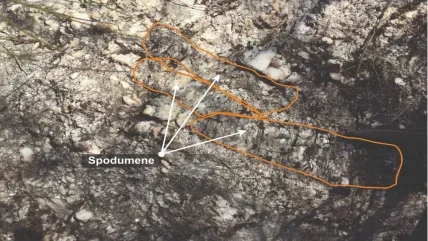
Savannah Resources, a UK-based mineral resource development company, has announced significant lithium mineralisation at its 100% owned Barroso Lithium Project in northern Portugal.
The company said that recent rock chip sampling and geological mapping have revealed new exploration targets across the C-100 and Aldeia Block B licence areas of the project. These findings are expected to enhance the potential for resource expansion in the region.
In the C-100 licence area, Savannah Resources discovered new mineralised pegmatites at the western end of the licence, creating additional exploration opportunities.
Extensions to previously known lithium mineralisation at Carvalha da Bacora and Altos dos Cortiços were confirmed. Rock chip sampling returned significant lithium grades, with results of 1.66% Li₂O, 1.5% Li₂O, 1.75% Li₂O, and 1.46% Li₂O at Carvalha da Bacora, while Altos dos Cortiços recorded grades of 3.01% Li₂O and 1.9% Li₂O.
At the Aldeia Block B licence area, reconnaissance sampling identified new lithium-bearing pegmatites beyond Savannah Resources’ earlier estimates.
Rock chip samples revealed lithium grades of 2.11% Li₂O and 1.32% Li₂O. Channel sampling returned notable results, including 6m at 1.39% Li₂O from Trench 1, 14m at 1.01% Li₂O from Trench 1b, and 4m at 2.08% Li₂O and 4m at 2.62% Li₂O from Trench 2.
The identified pegmatites follow structural trends observed at the Reservatório deposit, with some zones showing a potential strike length of 500m.
Savannah Resources CEO Emanuel Proença said: “All of these results come from targets which have received little or no significant exploration work to date and are separate to the Project’s five existing orebodies, all of which themselves have known extensions we are still to fully define.
“While there remains much work to do as a result of these initial high-grade chip and channel samples, the early conclusion is very clear: the Barroso Lithium Project remains highly prospective for further spodumene lithium resource delineation.”
Savannah Resources also conducted a light detection and ranging (LIDAR) survey at the Barroso Lithium Project, revealing historical tin mining areas at Grandão and Pinheiro that had been obscured by vegetation. These zones suggest a possible correlation between tin-bearing and spodumene-bearing pegmatites, which Savannah Resources plans to investigate further.
The company’s field programme involved collecting 110 samples and mapping pegmatites across the C-100 and Aldeia Block B licence areas.
Earlier drilling at Carvalha da Bacora intersected significant lithium mineralisation, including 26m at 1.09% Li₂O and 12m at 1.22% Li₂O.
Recent mapping identified additional pegmatites in this area, with rock chip samples yielding grades of up to 1.75% Li₂O. At Altos dos Cortiços, the pegmatite zone spans approximately 600m and returned lithium grades as high as 3.01% Li₂O.
The Barroso Lithium Project currently has a JORC-compliant resource of 28Mt at 1.05% Li₂O. Savannah Resources has previously demonstrated that surface outcrops can underestimate subsurface mineralisation, as drilling at Grandão and Pinheiro confirmed the continuity of pegmatite bodies.
Follow-up exploration is planned across the C-100 and Aldeia Block B licence areas, focusing on newly identified targets and extensions to existing orebodies.
Claimed to be Europe’s largest spodumene lithium deposit, the Barroso project is located near the town of Boticas and approximately 145km from the deep-water port of Leixões near Porto.
Savannah Resources initially acquired a 75% stake in the project in May 2017 and secured full ownership in 2019.
The lithium development company subsequently expanded the project by adding the Aldeia mining lease application, which includes three blocks totalling 2.94km², to the original C-100 Mining Lease. The C-100 lease spans 5.42km², is valid until 2036, and can be extended for a further 20 years.






